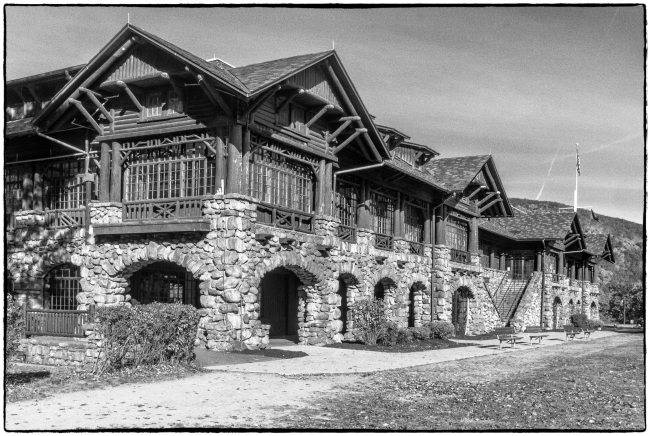I regularly monitor about 150 photography related feeds, one of which is Matthew Durr Photography. I’m accustomed to seeing his pictures of Japan so I was quite surprised to come across this one: Site Update 2016: Bear Mountain, Panoramas! in part because the Bear Mountain in question is a short drive (about 30 minutes) from where I live. I’ve been to Bear Mountain many times to walk the dog, and we once had a very pleasant meal at the Inn after my wife had had a spa treatment there. I was particularly interested in his first picture. Although I’ve been to this very location many times I’ve never noticed the cannon. Either it’s new or I merely missed it.
It occurred to me that I probably had a few pictures of the Bear Mountain Inn, which had never seen the light of day so I decided to take a look and sure enough there were some. One of them can be seen above.
The Inn has a rich history. As explained by Wikipedia:
The building has been called “among the earliest examples of a monumental rustic park lodge of a type that became common in state and national parks”. Construction required two years at a cost variously reported as $100,000 and $150,000. It was designed by the New York City firm of Tooker & Marsh, in a style strongly influenced by the Adirondack Great Camps.
Stone used in the foundations, wall facades and the two remarkably large fireplaces, was obtained from old walls on the properties acquired for Bear Mountain State Park. Chestnut timber used for framing, certain trim, siding and floor-covering, was also obtained from local parklands and milled on site. Despite appearances to the contrary, the building’s basic framework is constructed of steel.
The 1915 cellar contained an electric lighting plant that was also planned to furnish power for an escalator from the excursion boat landing to the plateau on which the inn stands. The ground floor included a “luncheon counter” while on the second floor veranda, “moderately priced Table d’hote” meals were sold. The main dining room offered “service equal to any metropolitan restaurant.” According to a New York Times article published in June 1915, “There are no windows or doors. When cool weather comes, the upper floor is to be inclosed [sic] in glass.”
In 1922-23 the building became a year-round facility with steam heat and enclosed windows. The aim was in part to make it a center for winter sports. Between the 1930s and 1980s changes to the floor plan were made and some historic details and decorative motifs were concealed or lost, and much of the original, rustic furniture was removed. A current renovation aims to restore some of these details.
When it became used for overnight accommodations, the third floor was initially remodeled as a dormitory. Later, individual guest rooms were installed with shared bath facilities. In 1975, individual bathrooms were installed as part of a larger renovation.
At various times during the 1930s and 40s, the Brooklyn Dodgers baseball team, the New York Giants football team and the New York Knickerbockers basketball team made the inn and adjacent athletic facilities their training headquarters. Also during this period, entertainment headliners included Harry James and Tommy Dorsey, and some believe[weasel words] Kate Smith wrote her 1931 theme song “When the Moon Comes Over the Mountain” while at the inn. If so, the mountain in question might be Anthony’s Nose which lies to the east across the Hudson River.
Madame Chiang Kai-shek spent two weeks “in seclusion” at one of the outlying lodges of the Bear Mountain Inn in the spring of 1943, meeting with Wendell L. Willkie there on April 25 before proceeding to the White House for a brief stay.

